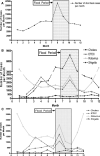Shifting prevalence of major diarrheal pathogens in patients seeking hospital care during floods in 1998, 2004, and 2007 in Dhaka, Bangladesh
- PMID: 18981509
- PMCID: PMC2749297
Shifting prevalence of major diarrheal pathogens in patients seeking hospital care during floods in 1998, 2004, and 2007 in Dhaka, Bangladesh
Abstract
Bangladesh experienced severe flooding and diarrheal epidemics in 2007. We compared flood data from 2007 with 2004 and 1998 for diarrheal patients attending the ICDDR,B hospital in Dhaka. In 2007, Vibrio cholerae O1 (33%), rotavirus (12%), and enterotoxigenic Escherichia coli (ETEC) (12%) were most prevalent. More severe dehydration was seen in 2007 compared with 2004 and 1998 (P < 0.001). In 2007, V. cholerae O1 Inaba (52%) and Ogawa (48%) were seen, whereas in 2004 and 1998 it was primarily Inaba and the Ogawa types, respectively (P < 0.001). In 2007, 51% of ETEC produced the heat labile toxin (LT) (P < 0.001 compared with 2004), 22% expressed the heat stable (ST) (P < 0.001), and 27% were ST/LT positive (P = 0.231). The CS7 colonization factor (CF) was the most prevalent in 2007 (20% compared with 6% in 2004; P = 0.05). Our findings demonstrate alterations in clinical features and phenotypic changes of major bacterial pathogens in the recent Bangladesh flood.
Figures

Similar articles
-
Impact of rapid urbanization on the rates of infection by Vibrio cholerae O1 and enterotoxigenic Escherichia coli in Dhaka, Bangladesh.PLoS Negl Trop Dis. 2011 Apr 5;5(4):e999. doi: 10.1371/journal.pntd.0000999. PLoS Negl Trop Dis. 2011. PMID: 21483709 Free PMC article.
-
A snap-shot of a diarrheal epidemic in Dhaka due to enterotoxigenic Escherichia coli and Vibrio cholerae O1 in 2022.Front Public Health. 2023 Apr 14;11:1132927. doi: 10.3389/fpubh.2023.1132927. eCollection 2023. Front Public Health. 2023. PMID: 37124777 Free PMC article.
-
Shift in phenotypic characteristics of enterotoxigenic Escherichia coli (ETEC) isolated from diarrheal patients in Bangladesh.PLoS Negl Trop Dis. 2014 Jul 17;8(7):e3031. doi: 10.1371/journal.pntd.0003031. eCollection 2014 Jul. PLoS Negl Trop Dis. 2014. PMID: 25032802 Free PMC article.
-
Vaccines for viral and bacterial pathogens causing acute gastroenteritis: Part II: Vaccines for Shigella, Salmonella, enterotoxigenic E. coli (ETEC) enterohemorragic E. coli (EHEC) and Campylobacter jejuni.Hum Vaccin Immunother. 2015;11(3):601-19. doi: 10.1080/21645515.2015.1011578. Hum Vaccin Immunother. 2015. PMID: 25715096 Free PMC article. Review.
-
A review of the current status of enteric vaccines.P N G Med J. 1995 Dec;38(4):325-31. P N G Med J. 1995. PMID: 9522876 Review.
Cited by
-
Resistance Pattern and Molecular Characterization of Enterotoxigenic Escherichia coli (ETEC) Strains Isolated in Bangladesh.PLoS One. 2016 Jul 18;11(7):e0157415. doi: 10.1371/journal.pone.0157415. eCollection 2016. PLoS One. 2016. PMID: 27428376 Free PMC article.
-
Floods and diarrheal morbidity: Evidence on the relationship, effect modifiers, and attributable risk from Sichuan Province, China.J Glob Health. 2022 Jul 25;12:11007. doi: 10.7189/jogh.12.11007. J Glob Health. 2022. PMID: 35871400 Free PMC article.
-
The increased severity in patients presenting to hospital with diarrhea in Dhaka, Bangladesh since the emergence of the hybrid strain of Vibrio cholerae O1 is not unique to cholera patients.Int J Infect Dis. 2015 Nov;40:9-14. doi: 10.1016/j.ijid.2015.09.007. Epub 2015 Sep 25. Int J Infect Dis. 2015. PMID: 26409202 Free PMC article.
-
Vaccines for preventing enterotoxigenic Escherichia coli (ETEC) diarrhoea.Cochrane Database Syst Rev. 2013 Jul 5;2013(7):CD009029. doi: 10.1002/14651858.CD009029.pub2. Cochrane Database Syst Rev. 2013. PMID: 23828581 Free PMC article.
-
The impact and cost-effectiveness of controlling cholera through the use of oral cholera vaccines in urban Bangladesh: A disease modeling and economic analysis.PLoS Negl Trop Dis. 2018 Oct 9;12(10):e0006652. doi: 10.1371/journal.pntd.0006652. eCollection 2018 Oct. PLoS Negl Trop Dis. 2018. PMID: 30300420 Free PMC article.
References
-
- Rashid SF. The urban poor in Dhaka City: their struggles and coping strategies during the floods of 1998. Disasters. 2000;24:240–253. - PubMed
-
- Siddique AK, Baqui AH, Eusof A, Zaman K. 1988 floods in Bangladesh: pattern of illness and causes of death. J Diarrhoeal Dis Res. 1991;9:310–314. - PubMed
-
- WHO Cholera, 2003. Wkly Epidemiol Rec. 2004;79:281–288. - PubMed
Publication types
MeSH terms
Grants and funding
LinkOut - more resources
Full Text Sources
Medical
